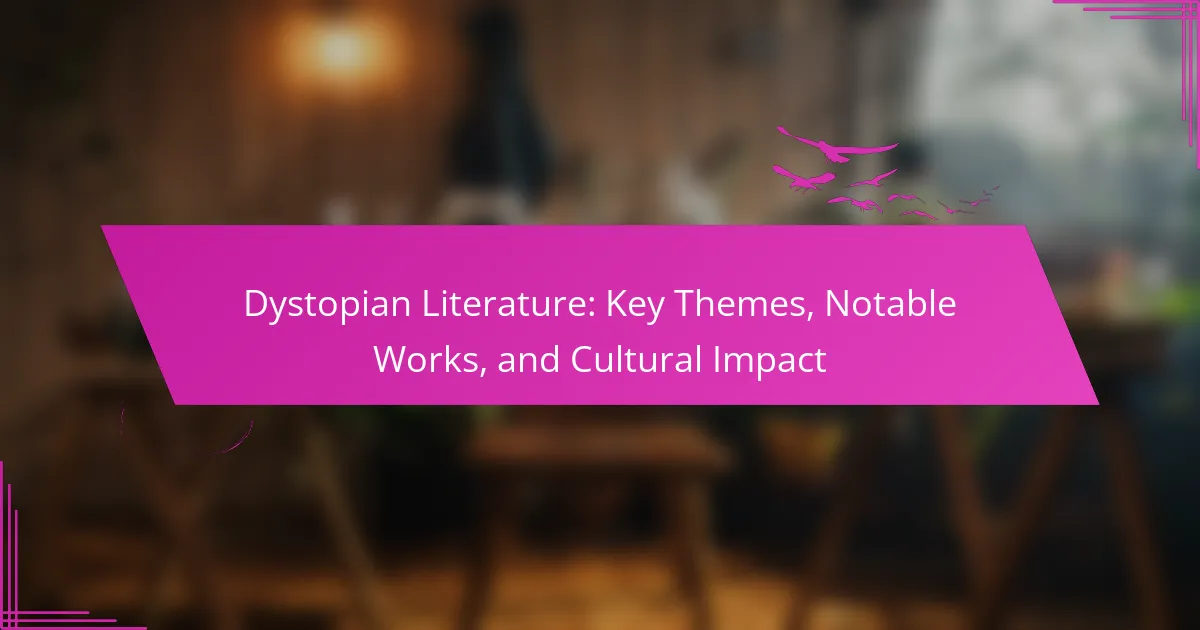Dystopian literature explores significant societal fears, addressing themes like totalitarianism, surveillance, and environmental disaster. Key works include “1984,” “The Handmaid’s Tale,” and “Fahrenheit 451.” These narratives reflect cultural anxieties and prompt critical discussions about freedom and morality. The genre’s evolution continues to mirror contemporary issues, ensuring its relevance in today’s literary landscape.
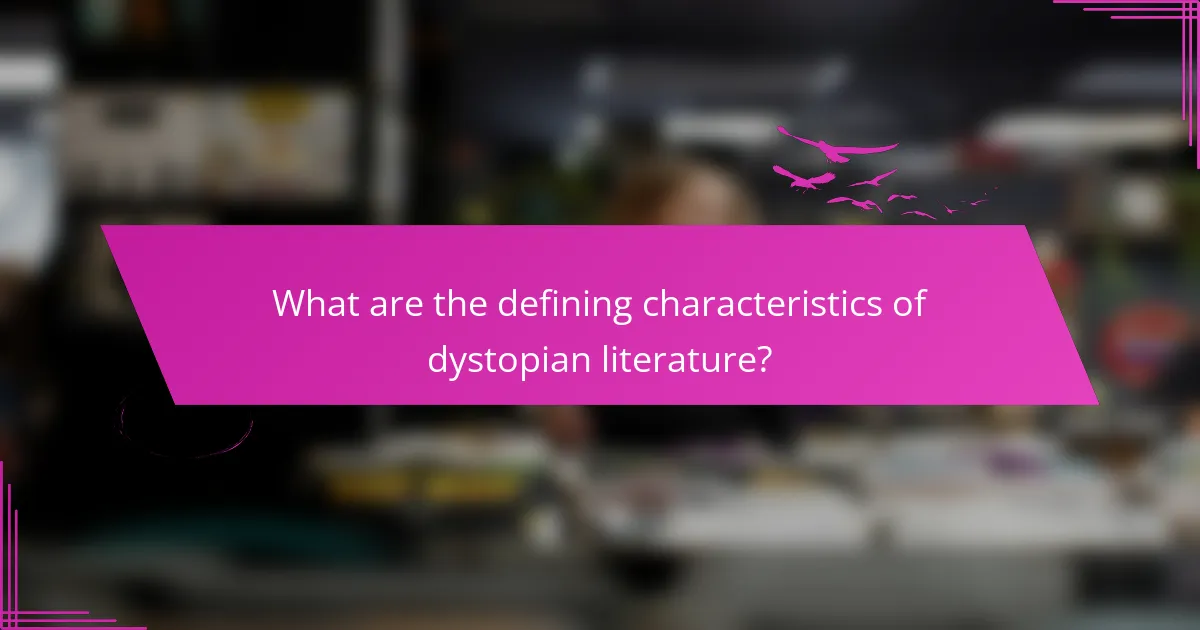
What are the defining characteristics of dystopian literature?
Dystopian literature is characterized by oppressive societal control, often exploring themes of totalitarianism, surveillance, and environmental disaster. Common attributes include a bleak setting, loss of individuality, and a critique of contemporary social issues. Notable works like “1984” and “The Handmaid’s Tale” exemplify these themes, reflecting cultural anxieties and prompting critical discussions about freedom and morality. The genre’s impact lies in its ability to provoke thought and inspire social change, making it a vital aspect of literary discourse.
How do societal fears shape dystopian narratives?
Societal fears significantly shape dystopian narratives by reflecting contemporary anxieties about the future. These fears often stem from issues like authoritarianism, environmental collapse, and technological overreach. For example, George Orwell’s “1984” illustrates concerns about totalitarianism and surveillance, while Margaret Atwood’s “The Handmaid’s Tale” addresses gender oppression and loss of autonomy. Dystopian literature serves as a critique of societal norms, prompting readers to reflect on current realities. This genre remains relevant as it evolves with shifting societal fears, offering a lens through which to examine potential futures.
Which literary techniques enhance the impact of dystopian themes?
Literary techniques such as symbolism, irony, and foreshadowing significantly enhance the impact of dystopian themes. Symbolism conveys deeper meanings, representing societal issues through objects or characters. Irony highlights contradictions in dystopian societies, revealing the disparity between ideals and reality. Foreshadowing builds tension, hinting at future events that reinforce thematic elements of despair and control. These techniques immerse readers in the dystopian experience, prompting critical reflection on contemporary issues.
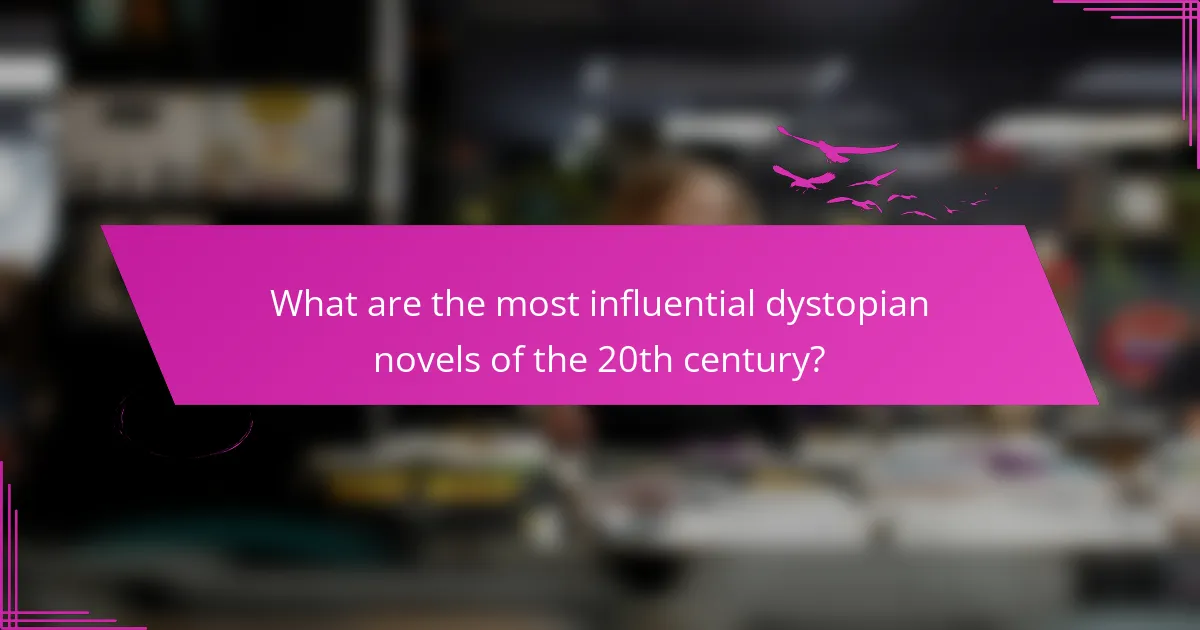
What are the most influential dystopian novels of the 20th century?
The most influential dystopian novels of the 20th century include “1984” by George Orwell, “Brave New World” by Aldous Huxley, and “Fahrenheit 451” by Ray Bradbury. These works explore themes of totalitarianism, surveillance, and censorship, shaping cultural discourse on freedom and individuality.
“1984” depicts a society under constant surveillance, highlighting the dangers of oppressive governments. “Brave New World” presents a future where happiness is manufactured, critiquing consumerism and societal control. “Fahrenheit 451” addresses censorship, emphasizing the importance of literature and critical thought in society.
These novels have left a lasting impact on literature and continue to resonate in discussions about personal freedoms and societal norms. Their exploration of dystopian themes serves as a cautionary tale against the potential consequences of unchecked power.
How does George Orwell’s “1984” reflect contemporary concerns?
George Orwell’s “1984” reflects contemporary concerns about surveillance, authoritarianism, and the manipulation of truth. The novel illustrates the dangers of totalitarian regimes, highlighting issues like privacy invasion and state control over information. These themes resonate today as governments and corporations increasingly monitor citizens and influence public perception. The concept of “Big Brother” serves as a warning against the erosion of personal freedoms in modern society. By exploring the psychological impact of oppressive systems, “1984” remains relevant in discussions about civil liberties and societal compliance.
What unique perspectives do Margaret Atwood’s works offer?
Margaret Atwood’s works offer unique perspectives on gender dynamics, environmental issues, and authoritarianism. Her dystopian narratives explore the consequences of societal choices, emphasizing women’s experiences and resilience. Atwood’s ability to blend speculative fiction with contemporary concerns invites readers to reflect on current realities and potential futures. The Handmaid’s Tale exemplifies how oppressive regimes can arise from complacency, while Oryx and Crake critiques genetic engineering and ecological degradation. These themes resonate widely, making Atwood’s contributions significant in both literature and cultural discourse.
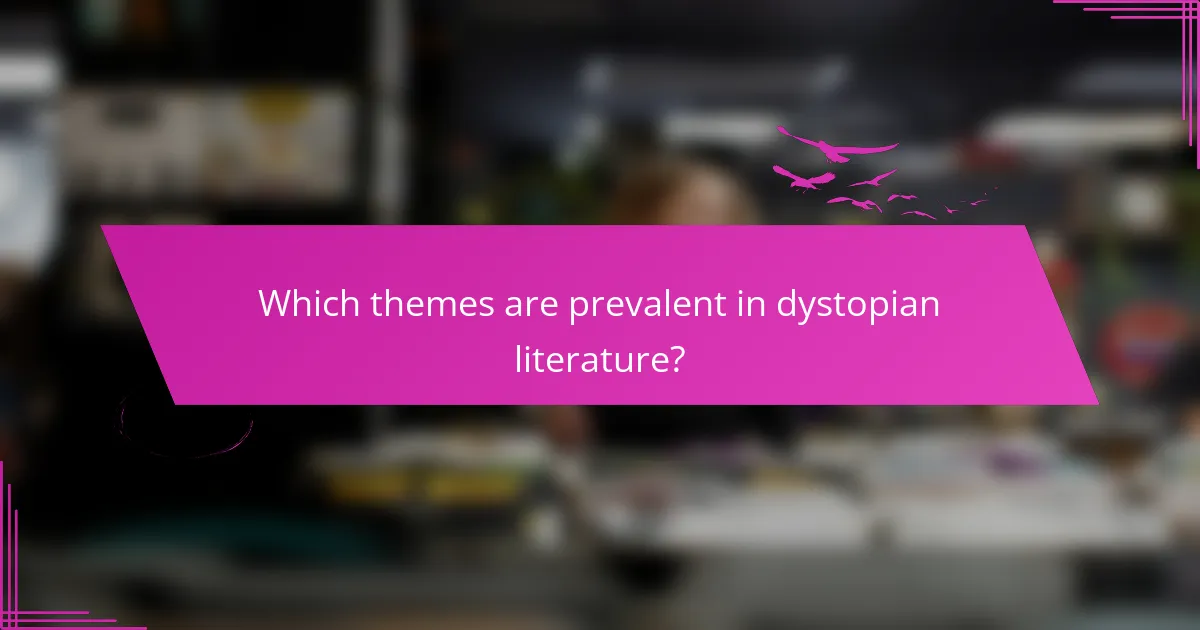
Which themes are prevalent in dystopian literature?
Dystopian literature often explores themes of totalitarianism, environmental catastrophe, surveillance, and social inequality. These themes reflect societal fears and critiques of contemporary issues.
Totalitarianism depicts oppressive governments controlling individual freedoms, as seen in George Orwell’s “1984.” Environmental catastrophe highlights the consequences of neglecting nature, exemplified in works like “The Road” by Cormac McCarthy. Surveillance addresses privacy invasion, notably in “Fahrenheit 451” by Ray Bradbury. Social inequality reveals class struggles, illustrated in “The Hunger Games” by Suzanne Collins.
These themes resonate with readers, fostering discussions about morality, freedom, and the future of humanity. Dystopian narratives serve as cautionary tales, prompting reflection on current societal trajectories.
How does the theme of surveillance manifest in modern dystopian works?
Surveillance is a central theme in modern dystopian works, often symbolizing control and oppression. Authors like George Orwell and Margaret Atwood illustrate how pervasive monitoring erodes privacy and individuality. In “1984,” constant surveillance by the Party exemplifies totalitarianism, while “The Handmaid’s Tale” portrays a society where surveillance enforces strict social roles. These narratives reflect contemporary concerns about technology, data privacy, and government overreach, highlighting the psychological impact of being watched. Through these examples, dystopian literature critiques societal trends and warns against the loss of freedom.
What role does environmental degradation play in dystopian storytelling?
Environmental degradation is a central theme in dystopian storytelling, often symbolizing societal collapse. It serves as a backdrop for exploring humanity’s relationship with nature and the consequences of neglecting environmental responsibility. Notable works like “The Road” by Cormac McCarthy depict barren landscapes, reflecting loss and survival. Such settings enhance the emotional weight of the narrative, prompting readers to consider real-world implications. As a result, environmental degradation in dystopian literature not only critiques current practices but also warns of potential futures shaped by ecological neglect.
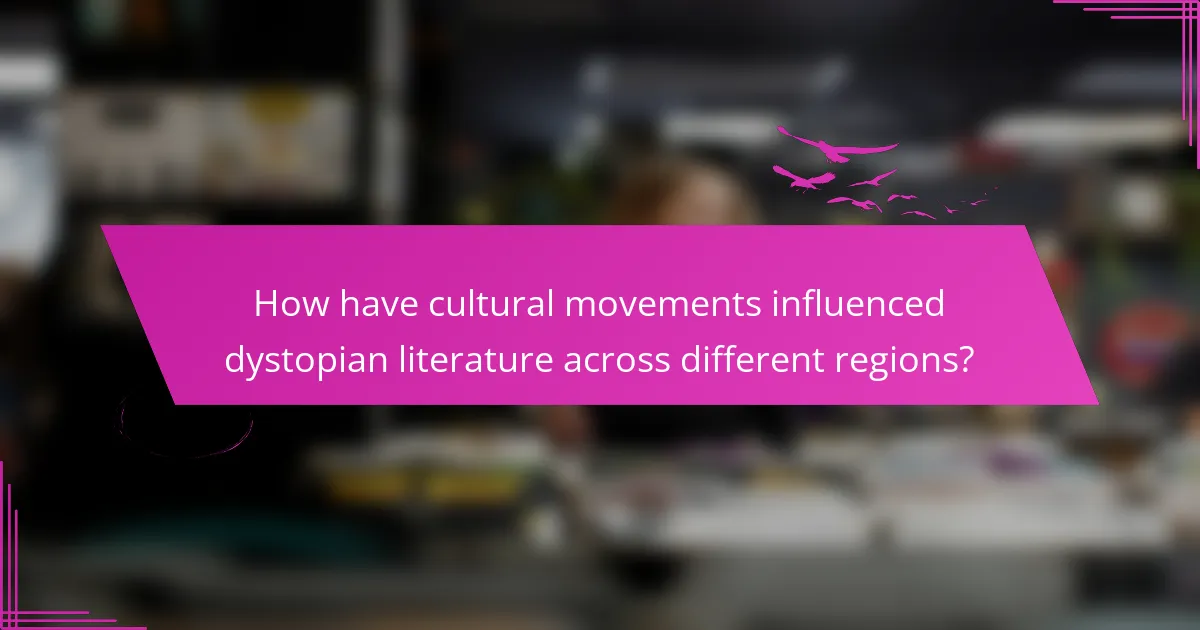
How have cultural movements influenced dystopian literature across different regions?
Cultural movements have significantly shaped dystopian literature, reflecting societal anxieties and aspirations. In the 20th century, movements like feminism and civil rights inspired works that explored oppression and resistance. For instance, Margaret Atwood’s “The Handmaid’s Tale” critiques patriarchal control, while George Orwell’s “1984” addresses totalitarianism, resonating with Cold War fears.
Regional influences further diversify the genre. In Latin America, magical realism intertwined with dystopian themes, as seen in “The Posthumous Memoirs of Brás Cubas” by Machado de Assis. In Asia, works like “The Wind-Up Bird Chronicle” by Haruki Murakami reflect the complexities of identity and societal change.
Dystopian literature often serves as a mirror to cultural movements, prompting readers to confront their realities. This genre continues to evolve, responding to contemporary issues like climate change and technological surveillance, ensuring its relevance across diverse cultures.
What impact did the Cold War have on dystopian fiction in North America?
The Cold War significantly influenced dystopian fiction in North America by reflecting societal fears and political tensions. Authors used dystopian narratives to critique authoritarianism and explore themes of surveillance, propaganda, and loss of individuality. Notable works like George Orwell’s “1984” and Ray Bradbury’s “Fahrenheit 451” emerged during this period, encapsulating the anxieties of nuclear war and totalitarian regimes. These stories resonated with audiences, providing a lens through which to examine contemporary issues and the consequences of unchecked power. As a result, dystopian fiction became a powerful medium for social commentary, shaping cultural discourse in a divided world.
How does European dystopian literature respond to historical events?
European dystopian literature often reflects historical events by critiquing societal issues and political climates. Works like George Orwell’s “1984” and Aldous Huxley’s “Brave New World” respond to totalitarian regimes and technological advancements. These narratives explore themes of oppression, surveillance, and loss of individuality, mirroring fears of authoritarianism. The cultural impact of these texts fosters discussions about freedom, ethics, and the consequences of unchecked power, highlighting their relevance to contemporary society.
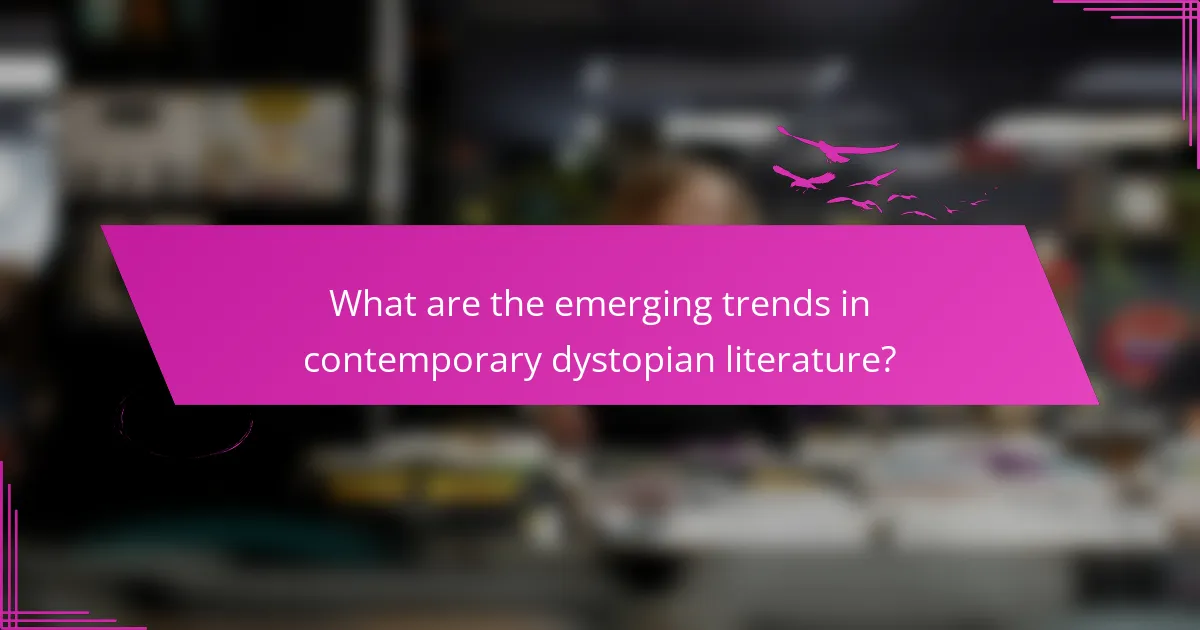
What are the emerging trends in contemporary dystopian literature?
Emerging trends in contemporary dystopian literature include climate change narratives, technology’s impact on society, and explorations of authoritarianism. These themes reflect current global anxieties and resonate with readers seeking to understand potential futures. Notable works often blend speculative fiction with social commentary, emphasizing the human experience amid oppressive systems.
How are technology and artificial intelligence portrayed in recent works?
Recent works portray technology and artificial intelligence as both dystopian threats and complex tools for societal change. Many narratives emphasize surveillance, loss of privacy, and dehumanization, reflecting contemporary anxieties about technological advancements.
Notable examples include “The Circle” by Dave Eggers, which critiques social media’s pervasive influence, and “Neuromancer” by William Gibson, which explores the fusion of human consciousness with technology. These works highlight the potential consequences of unchecked technological growth.
Culturally, these themes resonate with audiences, prompting discussions about ethical implications and the future of human interaction with technology. The portrayal of AI often embodies fears of autonomy and control, underscoring a unique attribute of contemporary dystopian literature.
What role do marginalized voices play in redefining dystopian narratives?
Marginalized voices play a crucial role in redefining dystopian narratives by introducing diverse perspectives and experiences. These voices challenge dominant narratives, emphasizing themes of oppression, resilience, and social justice. Notable works, such as Octavia Butler’s “Parable of the Sower,” highlight the unique struggles of marginalized communities in dystopian settings. As a result, these narratives foster empathy and provoke critical discussions about power dynamics and societal structures. This shift enriches the genre, making it more inclusive and reflective of real-world issues.
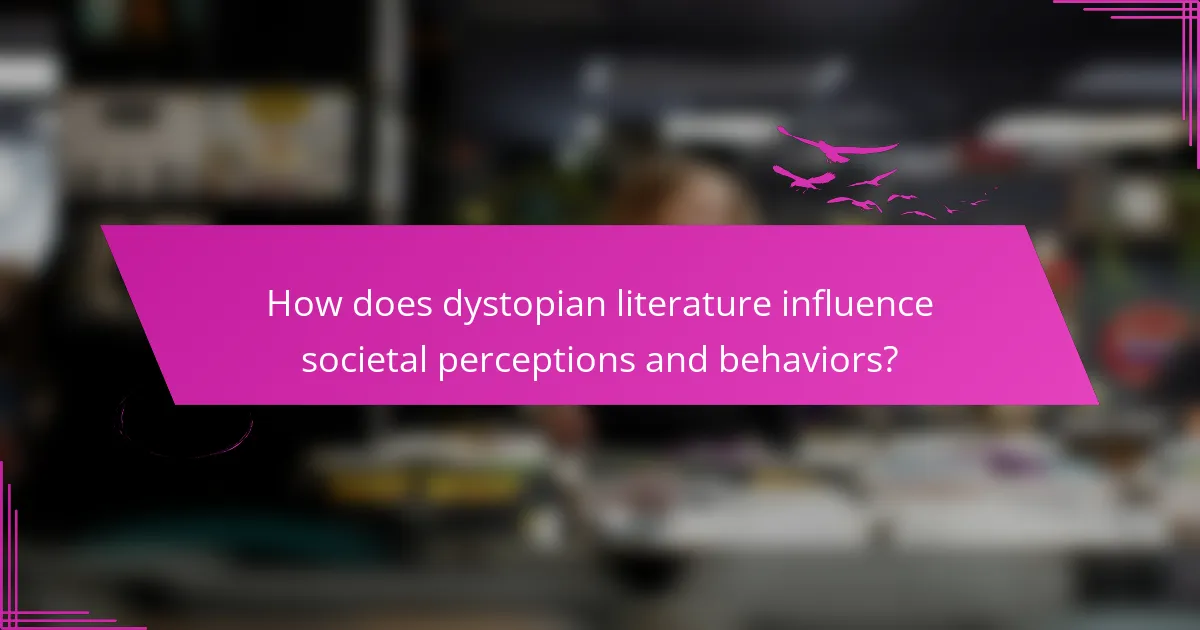
How does dystopian literature influence societal perceptions and behaviors?
Dystopian literature significantly shapes societal perceptions and behaviors by reflecting fears and critiques of contemporary issues. These narratives often explore themes of oppression, surveillance, and environmental collapse, prompting readers to question authority and societal norms. Notable works like “1984” and “The Handmaid’s Tale” illustrate how dystopian scenarios can mirror real-world challenges, enhancing awareness and fostering discussions about freedom and ethics. As a result, such literature encourages critical thinking and activism, influencing societal attitudes toward governance and individual rights.
What lessons can be learned from dystopian narratives regarding governance?
Dystopian narratives reveal critical lessons about governance, emphasizing the dangers of authoritarianism and the importance of civic engagement. These stories often showcase how power can corrupt, leading to oppression and loss of individual freedoms. They highlight the consequences of complacency in the face of injustice and the need for vigilance to protect democratic values. By examining these themes, readers can better understand the complexities of governance and the necessity of accountability in leadership.
How do dystopian stories inspire activism and social change?
Dystopian stories inspire activism and social change by highlighting societal flaws and injustices. These narratives provoke critical reflection on current issues, motivating readers to engage in activism. Works like “1984” and “The Handmaid’s Tale” illustrate oppressive regimes, emphasizing the importance of vigilance against authoritarianism. As a result, these stories often serve as catalysts for movements advocating for human rights and social justice.
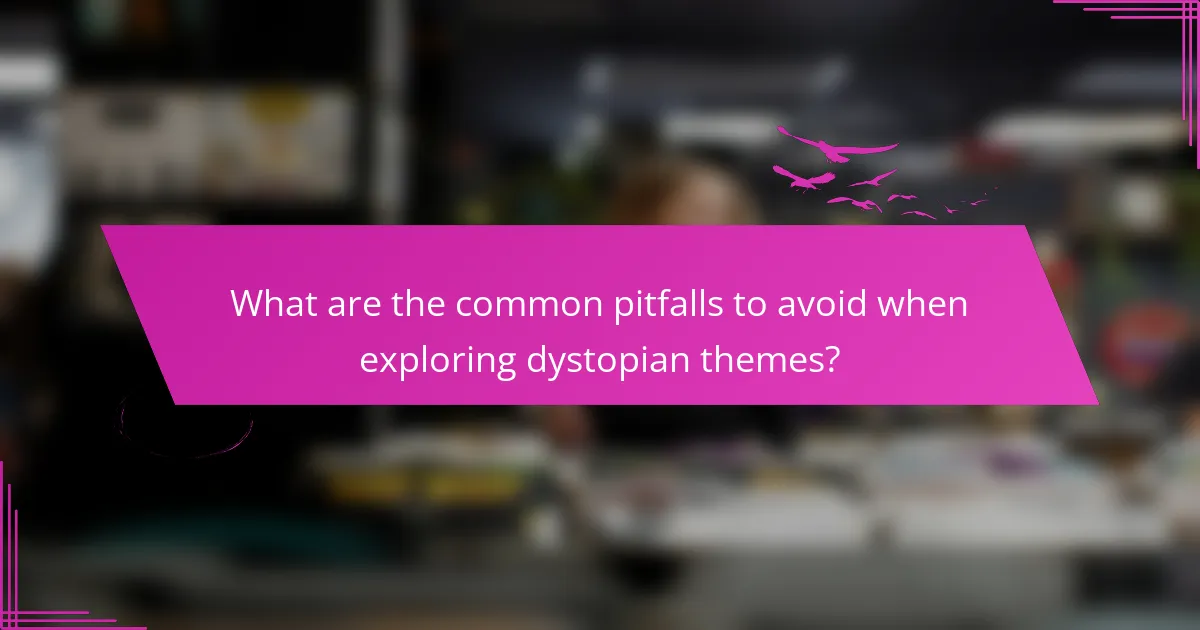
What are the common pitfalls to avoid when exploring dystopian themes?
Avoiding common pitfalls in dystopian literature includes neglecting character development, relying too heavily on clichés, and failing to provide a believable world. Strong characters enhance reader engagement, while originality in themes prevents predictability. Additionally, a well-structured narrative is critical; disjointed plots can confuse readers. Lastly, overlooking current societal issues may result in a disconnect from the audience, diminishing the cultural impact of the work.
How can readers critically engage with dystopian literature?
Readers can critically engage with dystopian literature by analyzing themes, character motivations, and societal critiques. This genre often reflects real-world issues, encouraging readers to question authority and envision alternate futures. Notable works like “1984” and “The Handmaid’s Tale” illustrate the consequences of oppressive regimes. Engaging with these texts fosters awareness of current social dynamics and inspires discussions on freedom, technology, and morality.
What strategies enhance the understanding of complex dystopian narratives?
To enhance understanding of complex dystopian narratives, employ strategies such as thematic analysis, character exploration, and contextual framing.
Thematic analysis helps identify core themes like oppression, surveillance, and environmental decay, enriching comprehension. Character exploration reveals motivations and conflicts, aiding readers in connecting emotionally with the narrative. Contextual framing situates the story within historical or social realities, allowing for deeper insights into its implications.
Engaging with supplementary materials, such as critiques and analyses, can further illuminate the intricacies of the narrative, fostering a more nuanced understanding.
